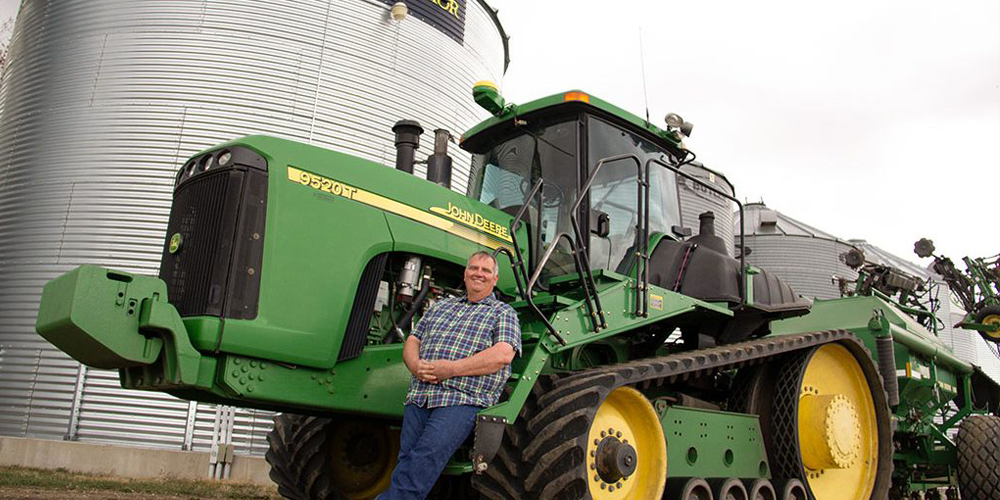Celebrating agriculture’s role.

The pandemic has helped us all focus on what is really important in life — the essentials. And food is one of them. Grocery stores never closed because food kept growing and farmers and gardeners kept harvesting it and selling it to distributors.
The life of a farmer is often misunderstood and undervalued. Farmers work hard. They are smart people who watch not only the weather but also markets, economic trends, and new products. They are willing to take risks and stick with tough situations because they love the land, they love the freedom to manage their businesses, and they are committed to producing products that sustain life on our planet.
The state of North Dakota in the United States is rooted in agriculture. Agriculture is a vital economic force, with about 90 percent of the state’s land being used for agriculture, totaling 39.3 million acres devoted to farming and ranching. North Dakota’s sub-humid continental climate is perfect for producing small grains, helping make it a top producer of dry edible beans, navy and pinto beans, flaxseed, and honey. It is also the top producer of durum and spring wheat.
Larry Stolz lives in Sykeston, North Dakota, with his wife, Joye, and farming has been a part of his life since childhood. They live in his childhood home, and Stolz farms the land his father farmed. Stolz grew up working alongside his father, planting, maintaining, and harvesting crops. During his college years, he branched out on his own, rented some land, and with the use of his father’s machinery, he planted crops and managed his own small business that helped pay most of his tuition at Union College, a Seventh-day Adventist school in Lincoln, Nebraska.
The life of a farmer is varied. North Dakota’s spring and summer are short compared to other climates, but farming never takes a back seat even during the “off” season. There is always something to do. Winter months are sprinkled with grain hauling and inside work such as machinery maintenance. January sees the finalization of accounting, tax filing, and other reports. March is the time to take inventory and buy the remaining supplies needed to last through the year. Various machinery is being removed from storage and given a once-over, making sure everything is ready for the spring. Trucks and cars are serviced, carburetors are cleaned, and attention is given to ensure things are running smoothly. Mid-April to early June, fertilizers are applied to fields and seeding begins, along with spraying the fields to manage insects and various plant diseases that may impact the crops. A lull comes in July as the fields grow and flourish, and then the harvesting season begins and continues through October.
Barley, canola, hard red spring wheat, sunflowers, and soybeans can all be seen on the land that Stolz farms. Have you ever seen a field of blooming canola? The bright yellow flowers undulating in the wind can almost fool your eye into believing you are watching a golden ocean’s waves move across the landscape. Sunflowers move with the sun, their bright, beautiful heads turning to take in every ray. Even harvest lends beauty to the landscape as rows of freshly cut golden wheat weave across the countryside.
“It is gratifying to see the process of multiplication, of life: from clean seed sprouting, growing, and maturing.” Stolz shares. “I love the variety of work I get to do, inside and out. Who wouldn’t want to drive a tractor? Setting our schedule in the off-season is also a blessing. I enjoy the quietness, the excitement, and sometimes even the chaos of farming. I love working with my hands, and the variety of work farming allows me to do.”
Farming does not come without its challenges. Living at work can take its toll. “It is important not to be consumed by it because the reality is that work is never truly done — there is always something to do. Taking time to rest and relax is important. I try not to worry about the things I can’t control,” Stolz adds.
There is also the uncertainty of a profitable return each year. Changes in grain prices, unexpected expenses for machinery repairs, and the weather all impact the bottom line.
Each year the weather plays a vital role in the yield. Excess moisture and drought can both impact quality and yield. Excess moisture can make it difficult to harvest, while areas that have gotten too much water can become inaccessible. Hail can also have an impact. Just a few years ago, Stolz was one day away from harvesting a beautiful crop of barley. A hailstorm came through and wiped out the field. Every head of barley was broken off at the stem. What would have been a field that yielded around 12,000 bushels yielded 1,000. (A bushel is a measure of dry goods capacity. In the case of barley, every bushel equals about 22 kilograms, or 48 pounds). The loss was significant. Even more interesting to note is that weather varies from mile to mile. Spotty showers or violent hailstorms can hit one field but completely miss the next.
“There are always two paths to choose in how we react to challenges,” Stolz says. “There are lessons we can learn from nature and through being dependent on the elements. The solitude gives a person a lot of time to think and process. We can never plan on bountiful crops and good prices. I don’t worry about it or even speculate because I am promised that my needs will be met by the One. And sometimes we need to realize that prosperity from big crops and high prices isn’t necessarily our need.”
Our homes are impacted daily by the farmers who dedicate their lives to the love of their vocation, this wondrous cycle of renewable food. There is a lot of work that happens from start to finish, including processing and distribution. And they always do their best to produce a food product that contributes to our health in a positive way while also being caretakers of the land from which they harvest.
The original version of this story was posted in the Mid-America Union Outlook magazine.








